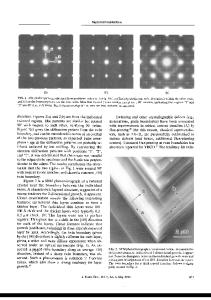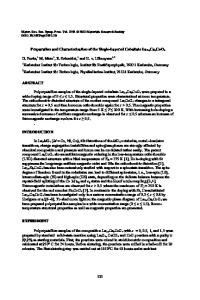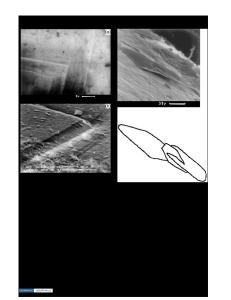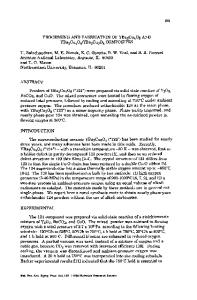Ion-Beam-Driven Amorphization of Ca 2 La 8 (SiO 4 ) 6 O 2 Single Crystals
- PDF / 386,590 Bytes
- 6 Pages / 414.72 x 648 pts Page_size
- 4 Downloads / 363 Views
Ca2Las(Si0 4 ) 6 0
2
SINGLE CRYSTALS
W. J. WEBER', N. J. HESS, and L. M. WANG** Pacific Northwest Laboratory, P.O. Box 999, Richland, WA 99352, USA "Department of Earth and Planetary Sciences, University of New Mexico, Albuquerque, NM 87131, USA
ABSTRACT Single crystals of Ca 2La 8(Si0 4)60 2, with 1% Nd substituted for La, were irradiated with 0.8 MeV Ne' and 1.5 MeV Kr' ions over the temperature range from 15 K to 773 K. The irradiations were carried out using the HVEM-Tandem Facility at Argonne National Laboratory. The structural changes and the ion fluence for complete amorphization were determined by in situ transmission electron microscopy. The ion fluence for complete amorphization increased with temperature in two stages associated with defect annealing processes. The critical temperature for amorphization increased from -360 K for 0.8 MeV Ne' to -710 K for 1.5 MeV Kr'. During in situ annealing studies, irradiation-enhanced recrystallization was observed at 923 K. Spatially-resolved fluorescence spectra of the Nd ion excited with 488.0 nm laser excitation Initial showed marked line-broadening toward the center of the amorphous regions. measurements indicate the subtle shifts of the '19,2 groundstate energy levels can be measured by pumping directly into the excited state 4F 312 manifold suggesting that the line broadening observed originates from a distribution of geometrically distorted Nd sites.
INTRODUCTION Understanding irradiation-induced amorphization and recrystallization in ceramics is important to the use and reliability of advanced ceramics in nuclear power application (fission
and fusion), to the safe storage of nuclear waste materials, and to the modification and tailoring of ceramic properties by energetic ion beams. A recent study of polycrystalline Ca 2Ndi(SiO4 )60 2 doped with 244Cm [1] showed that amorphization in this material occurs directly within the collision cascade of the Pu recoil nucleus emitted during alpha decay of Cm and that the fully amorphous state is reached at a dose equivalent to 0.4 dpa. Recrystallization of the fully amorphous state in this material occurs in a single recovery stage with an activation energy of 3.1 ± 0.2 eV [2]. In order to better understand the effect of temperature on the amorphization process, the effect of irradiation on recrystallization processes, and changes in the local structure, a systematic study of ion-beam-induced amorphization in single crystal Ca 2La 8(Si0 4)60 2 has been undertaken as part of a larger collaborative effort that includes other orthosilicates [3,4]. This paper expands on previous results [5,6], addresses the effects of temperature on irradiationinduced amorphization and recrystallization in Ca 2La 8(Si0 4)60 2, and reports on the use of spatially-resolved fluorescence techniques to investigate local distortions.
EXPERIMENTAL PROCEDURES The single crystals of Ca 2La 8(Si0 4)60 2 were grown from a stoichiometric melt by the Airtron Corp. and have the hexagonal apatite (P63/m) structure with lattice parameters: a, = 435
Data Loading...











